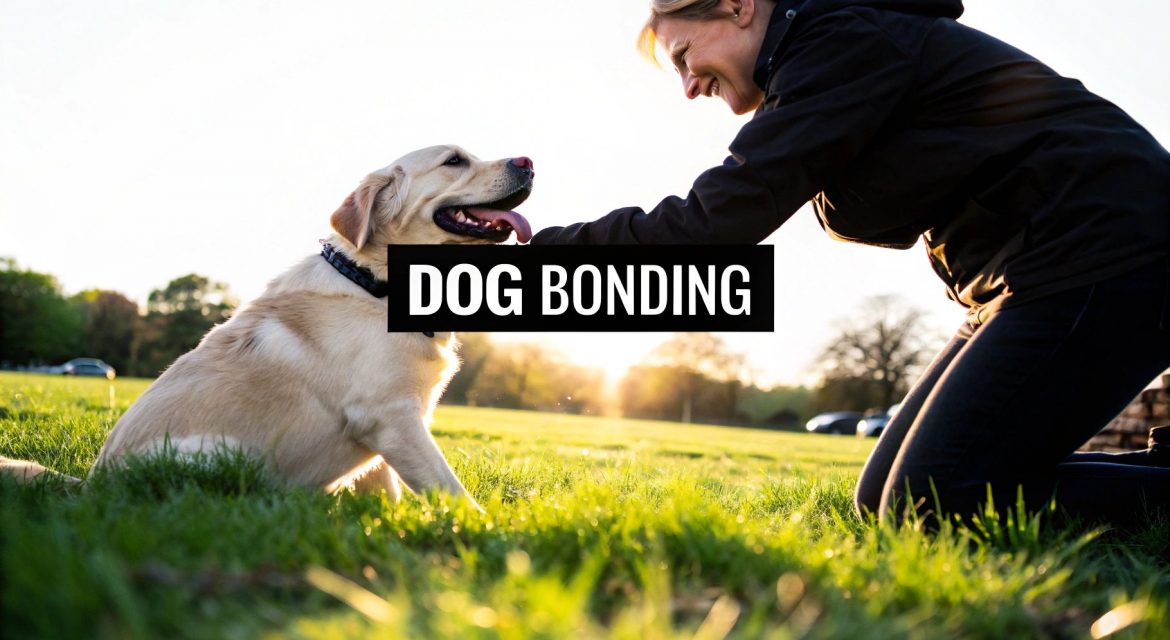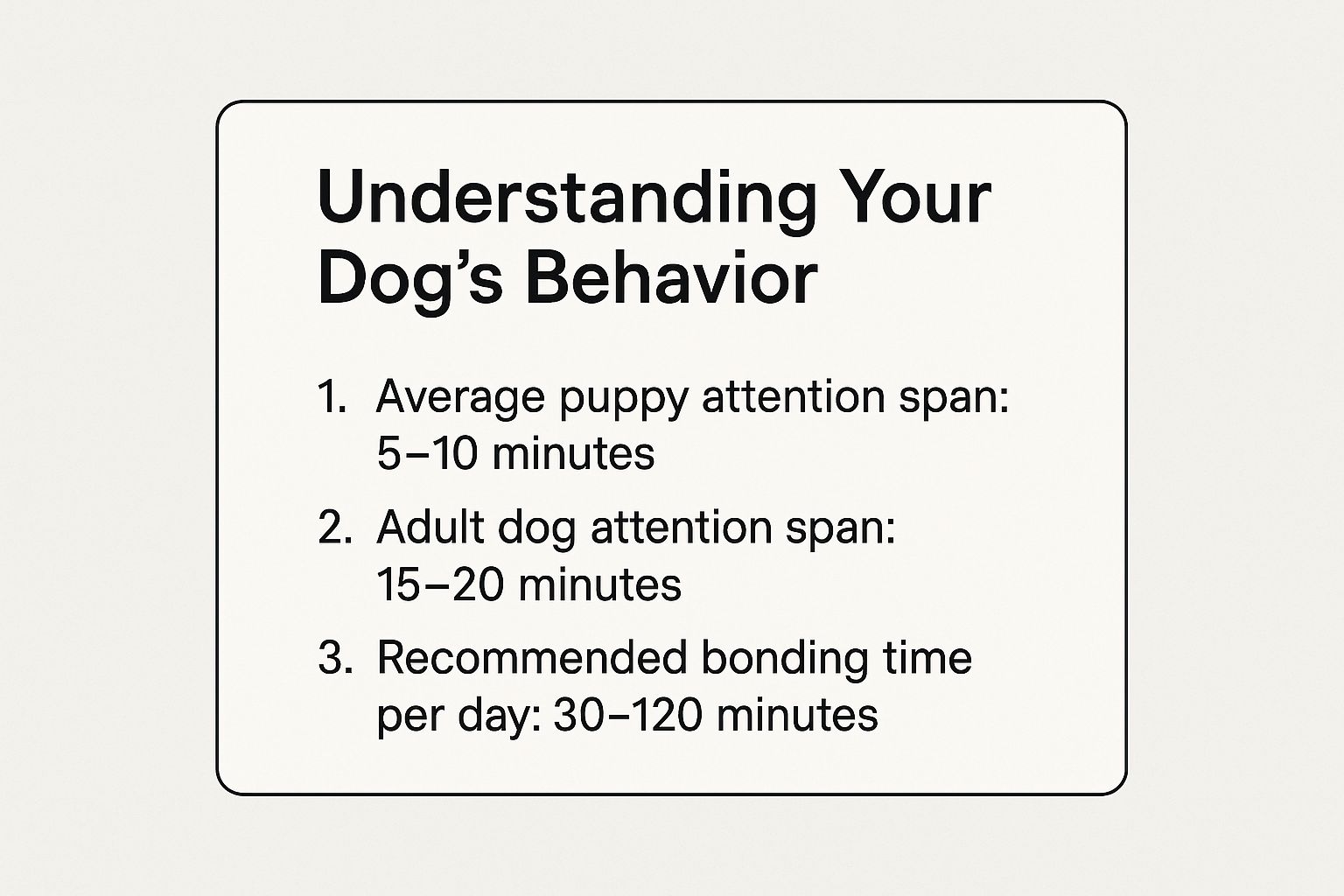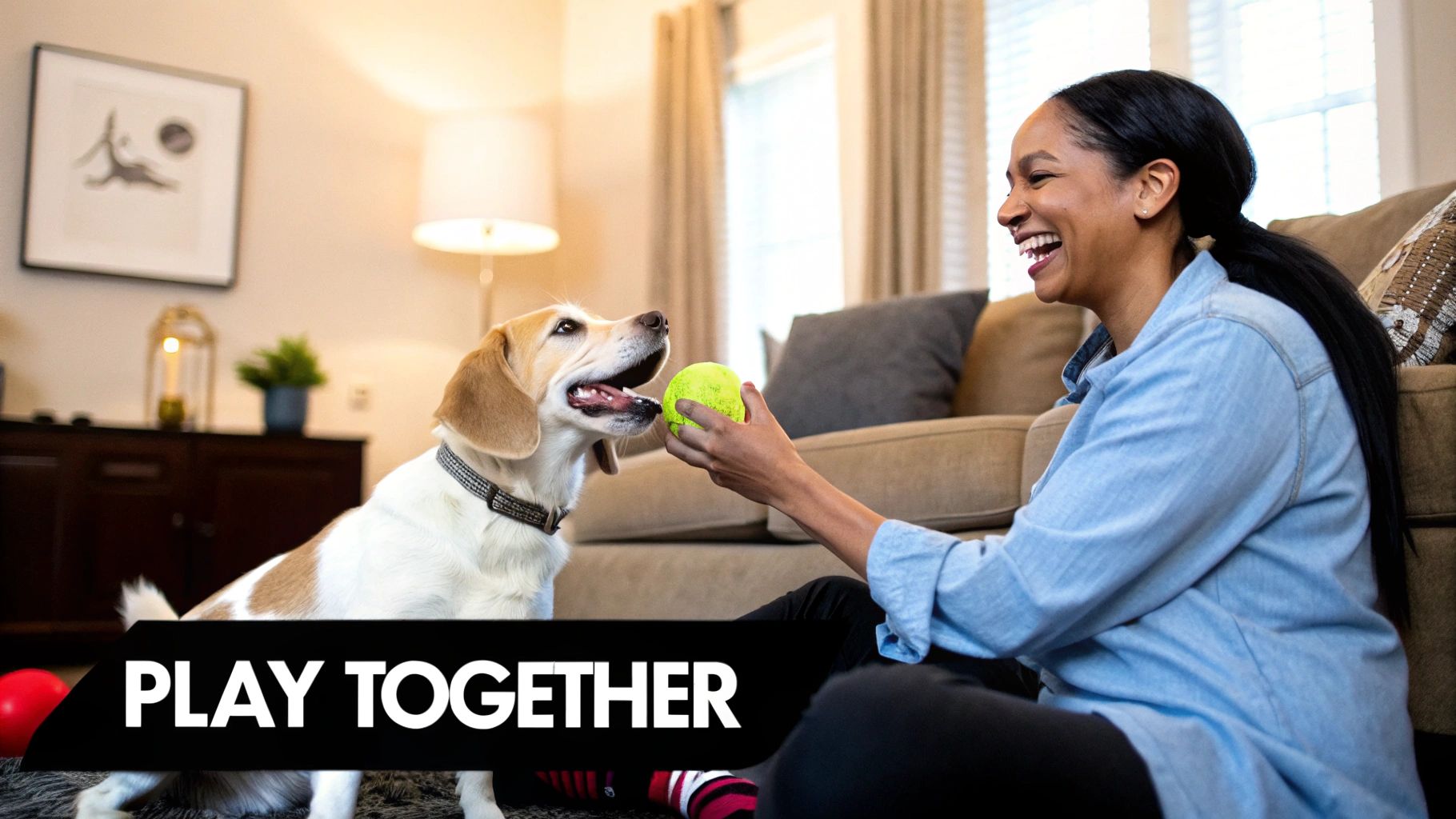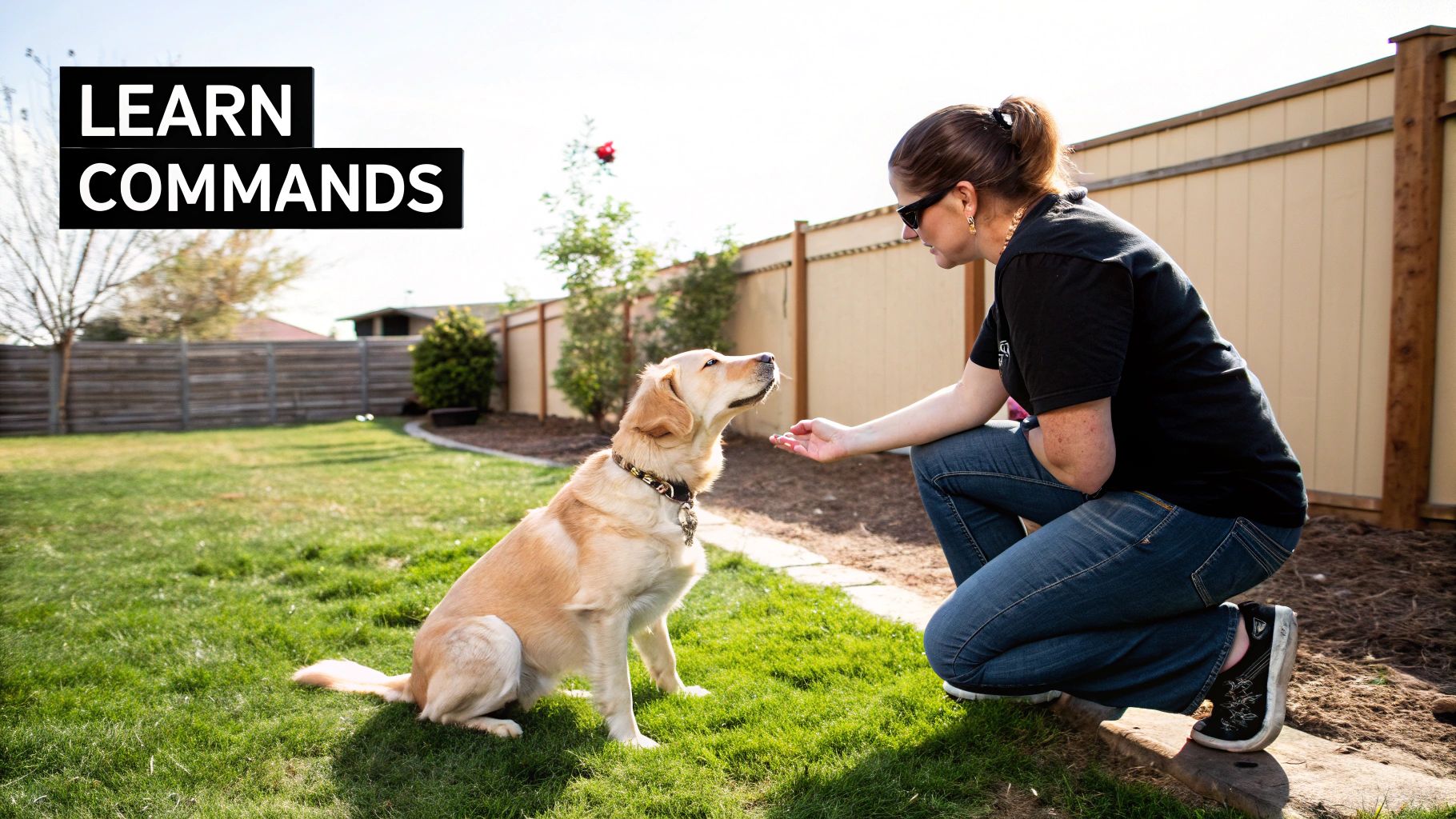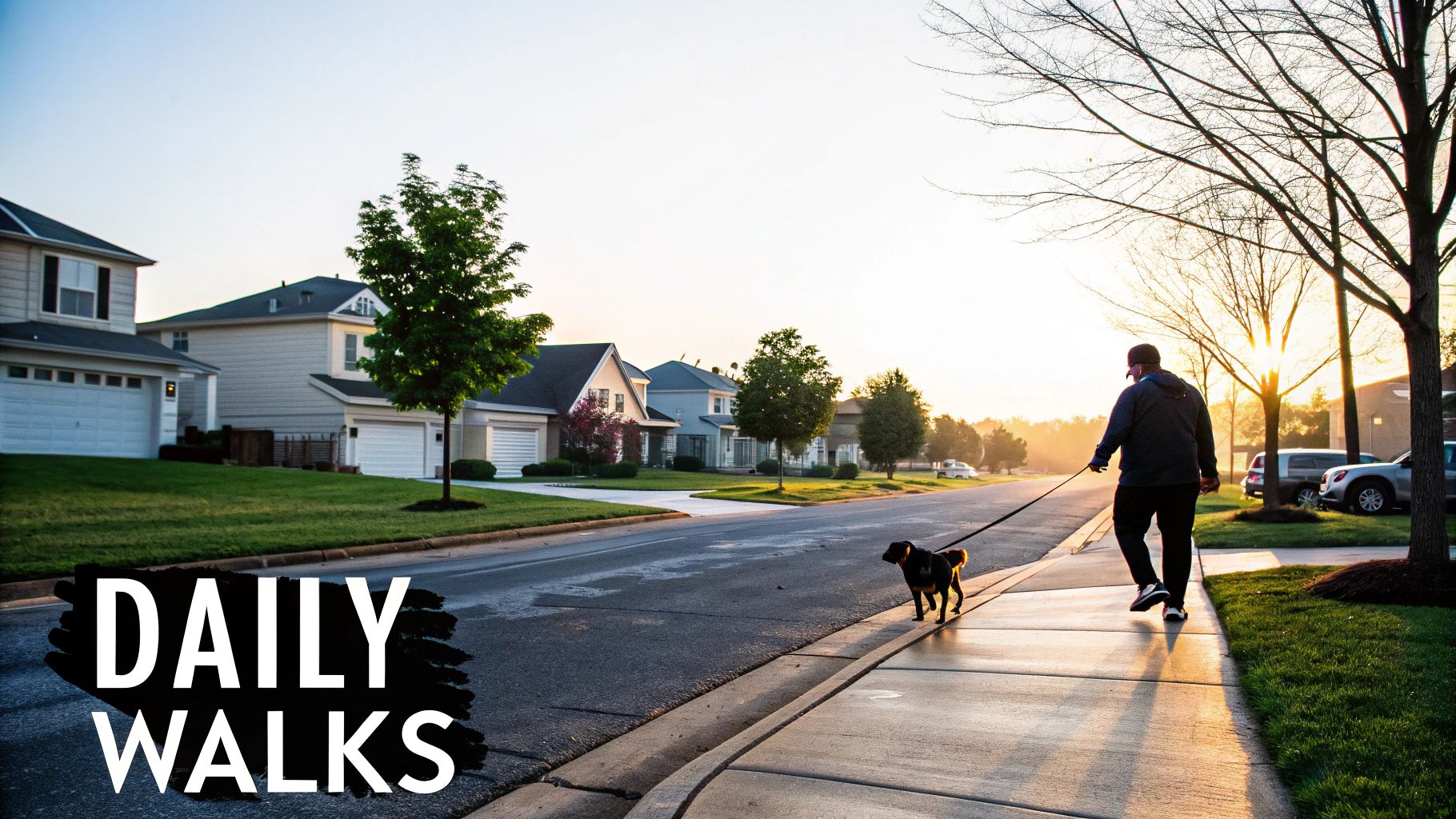Building a deep, loving bond with your dog is one of the most rewarding parts of sharing your life with them. It’s a journey of shared moments and learning to understand each other. This connection really comes down to four core pillars: clear communication, quality time, positive training, and consistent daily rituals. Nailing these areas helps us build a foundation of trust that will make both your lives richer for years to come.
Why a Strong Bond Is So Important
So, you want to deepen the connection you have with your dog. That’s fantastic. That incredible feeling of trust and mutual respect doesn't just appear overnight; it's something we build day by day through empathy, patience, and consistent effort from both of you.
A strong bond is absolutely vital for your dog's well-being. It gives them a sense of security that can help sidestep common behavioural issues that often stem from anxiety or confusion. When your dog feels safe and understood, they're more confident, happier, and just better equipped to handle whatever life throws at them. And for us? The benefits are just as profound, offering a kind of companionship and partnership you can't find anywhere else.
Think of this guide as a way to step into your dog's paws for a moment. It's about remembering that every dog is an individual with their own quirky personality. Let's get started on this journey together.
The Four Pillars of Dog Bonding At a Glance
To truly build that unbreakable bond, it helps to focus our efforts. These four pillars are the bedrock of a healthy, happy relationship with your dog. Think of them as your roadmap to a deeper connection.
| Pillar | Why It Matters | Simple First Step |
|---|---|---|
| Clear Communication | Your dog needs to understand you, and you need to understand them. It reduces frustration for everyone involved. | Start paying attention to your dog's body language—a tail wag isn't always a happy sign! Let's learn what a relaxed posture looks like versus a tense one. |
| Quality Time | It's not about the clock; it's about being present. Shared, focused activities strengthen your partnership. | Put your phone away for a 10-minute game of fetch or tug-of-war in the garden each day. No distractions, just you and your dog. |
| Positive Training | Training isn't just about obedience; it's a two-way conversation that builds trust and confidence. | Teach a fun new trick, like 'spin' or 'high-five'. Keep it short, light, and full of treats and praise. |
| Consistent Rituals | Predictable routines make your dog feel secure. They learn they can count on you for the important stuff. | Stick to a regular feeding time. This simple act of reliability shows your dog you're a dependable leader they can trust. |
Focusing on these areas consistently will do more for your relationship than any grand, one-off gesture ever could. It's the daily moments that count.
Understanding Your Dog's Needs
A huge part of bonding is simply recognising your dog's capabilities and limits. Not every dog is the same. The image below gives us a realistic idea of what to expect when it comes to attention spans and daily interaction.
As you can see, short, frequent interactions often work much better than one marathon session, especially if you have a puppy. It's all about quality over quantity.
And you're not alone in wanting this deeper connection. In the UK, where there are more than 13 million pet dogs, creating a strong bond is a goal we share in countless homes. Research shows time and again that one of the best ways to bond with your dog is through regular, positive engagement. Simple things like walks and playtime really do make all the difference. You can find more insights on the UK's dog population in this article from The Independent.
Key Takeaway: Building a bond isn't about grand gestures. It's about the small, consistent acts of love, understanding, and respect you show your dog every single day.
Learning to Speak Your Dog’s Language
Your dog is talking to you all the time, though not with words. To truly build a deep connection, we need to start learning their language. It goes far beyond the obvious happy tail wag or a warning growl; it's a rich, subtle world of ear twitches, eye contact, and body posture.
When you start tuning into these signals, you begin to understand what your dog is really feeling. This lets you respond with empathy, building a massive well of trust. When your dog feels genuinely heard and understood, they also feel safe—and safety is the absolute cornerstone of any strong relationship.
Decoding Common Body Language
Let’s get past the basics. That high, fast-wagging tail might look like pure joy, but it can just as easily signal over-arousal or even nervousness. The real story is often told by the rest of their body. For a deeper dive, it helps to learn how dogs communicate with people across different scenarios.
Here are a few specific cues to watch for that tell you what’s really going on inside that furry head:
- Whale Eye: This is when your dog turns their head away but keeps their eyes fixed on something, showing the whites. You might see this during a cuddle if they're feeling a bit crowded. It’s their polite way of saying, "I need a little space, please."
- Lip Licking and Yawning: When they aren't tired or hungry, these are often tell-tale signs of stress or anxiety. A dog might do this when meeting a new person or during a training session if they feel pressured. It's their way of trying to calm themselves down.
- Low, Slow Tail Wag: This isn't the happy-go-lucky wag we all know and love. A low, slowly sweeping tail can indicate uncertainty or insecurity. Your dog is likely assessing a situation and isn't quite sure how to feel about it yet.
By learning to spot these subtle signals, you shift from simply owning a dog to truly understanding your companion. You're showing them that their feelings matter, which is one of the most powerful ways to bond.
How Your Communication Affects Your Dog
Just as we need to understand their signals, we must also be mindful of our own. Dogs are absolute masters at reading our body language and tone of voice, often paying more attention to that than our actual words.
Think about how you interact with them. A high-pitched, excited "Who's a good boy?" sounds worlds apart from a firm, low "Leave it." Your tone carries immense weight and tells your dog exactly how to interpret a situation.
Similarly, getting down on their level and using soft, relaxed body language is far more inviting than standing over them, which can feel intimidating.
When we become better listeners and more conscious speakers, we create a safe and predictable environment. This consistent, clear communication is fundamental to strengthening your bond, transforming your relationship into a true partnership built on mutual respect and understanding.
Build Your Bond Through Play
Play is hands-down one of the best ways to deepen the relationship you have with your dog. It's so much more than just burning off a bit of energy; it's a shared language built on fun, trust, and teamwork. When we play together, we learn to read each other's signals and build a bank of brilliant memories.
This isn’t about just chucking a ball for an hour, though. The real magic happens when play is interactive and engaging for both of you. It's your chance to give your dog your undivided attention, showing them that, for a few minutes each day, they're the centre of your world.
Play to Your Dog's Strengths
Every dog is different, with their own unique quirks shaped by breed and personality. Figuring out what truly gets your dog excited is the secret to unlocking meaningful playtime. A bouncy Labrador might live for a game of fetch, their joy written all over their face with every leap.
But a clever Border Collie might find that a bit dull after a while. They often crave mental challenges, so a puzzle toy or a game of hide-and-seek would be far more rewarding. When you match the game to their natural instincts, you're not just playing—you're celebrating exactly who they are.
By choosing games that tap into your dog's inherent drives, you're sending a powerful message: "I see you, and I get you." This kind of validation is an incredible tool for strengthening your bond.
Fun Ideas for Interactive Games
Moving beyond the classic fetch can open up a whole new world of connection. Interactive games need you to work together, turning playtime into a proper team effort. These activities are fantastic for building your dog’s confidence and sharpening the communication between you both.
If you need more ideas to keep your dog's mind ticking over, have a look at our guide to great boredom busters for dogs. It's packed with ways to keep them entertained.
Here are a few games to get you started:
- Tug-of-War: This classic game is brilliant for teaching impulse control. Let's use a designated tug toy and set clear rules, like a solid "drop it" command. Letting your dog 'win' every now and then is a fantastic confidence booster!
- Scent Work: You don't need any fancy kit to get started with this. Just hide some of their favourite high-value treats around a room or in the garden and encourage them to "find it!" This taps into their amazing sense of smell and is hugely rewarding for them.
- Shared Adventures: Bonding isn’t just for the back garden. Exploring a new walking trail, visiting a dog-friendly beach, or just navigating a new park together creates shared positive experiences. These little adventures build a history of trust and fun between you.
A great tip is to always end your play sessions on a high. Put the toy away while your dog is still excited and having fun. This simple trick keeps them looking forward to your next game, reinforcing that time with you is the best part of their day.
Let's be honest, the word "training" can sometimes sound like a bit of a chore. But what if we reframed it? Instead of a task you have to tick off, think of it as one of the single most powerful ways you can bond with your dog.
It’s not just about teaching 'sit' or 'stay'. Every successful training session is a conversation where we both learn to understand each other better. You’re building a shared language based on trust and cooperation, which is the very heart of a strong relationship.
Keeping It Fun and Rewarding
The secret to making training a bonding activity is to keep it positive, short, and incredibly rewarding. Dogs, especially puppies, don't have the longest attention spans. A focused five-minute session is far more effective than a frustrating half-hour slog.
Positive reinforcement is your best friend here. This approach is all about rewarding the behaviour you want to see, which makes your dog genuinely want to work with you. Using high-value treats, enthusiastic praise, or a favourite toy strengthens their desire to please you because they associate learning with brilliant things. For more tips on this, check out our detailed guide on positive reinforcement dog training techniques.
Your dog doesn’t work for you; they work with you. When we use rewards, we're not bribing them—we're paying them for a job well done. This builds a partnership, not a dictatorship.
Mastering Skills Together Builds Confidence
Think about teaching a really solid recall or a reliable 'stay'. When your dog masters a new skill with your guidance, it builds immense confidence in them and in your leadership. Each successful "come" from across the park or patient "stay" while you open the door reinforces their trust in you.
These aren't just party tricks; they are life skills that keep your dog safe and make your lives together much easier. Mastering them as a team creates a powerful sense of accomplishment that you both share, strengthening your connection with every success.
This shared effort is especially important. For some households, training can become a source of stress. In fact, around 17% of families with children found dog training more challenging than they expected, which can put a strain on the bond if it’s not handled with patience.
Avoiding Common Frustrations
Even with the best intentions, training can sometimes get frustrating. If you feel yourself getting tense, your dog will feel it too. Here are a few tips from UK trainers to keep things on the right track:
- End on a High Note: Always finish your session with something you know your dog can do easily. This ensures they end with a success and a reward, leaving them excited for next time.
- Blame the Environment, Not the Dog: Is your dog struggling to focus? Is the TV on? Are there too many distractions? Instead of getting frustrated with your dog, let's try changing the environment to set them up for success.
- Celebrate the Small Wins: Did your dog hold their 'stay' for one second longer than last time? Brilliant! Acknowledge and reward every tiny step of progress.
By keeping sessions fun, fair, and full of encouragement, we transform training from a simple task into a cherished ritual. It becomes dedicated time where you and your dog connect, communicate, and grow together, building an unbreakable bond one treat at a time.
Build Your Bond Through Daily Routines
Grand adventures and long hikes are fantastic, but they aren't where the real magic happens. The strongest, most unbreakable bonds are forged in the small, quiet moments you share every single day.
Weaving simple, consistent rituals into your daily life creates a predictable world for your dog, showing them they can count on you. This reliability is the absolute bedrock of trust.
It’s all about turning mundane tasks into meaningful connection points. These small, repeated acts of care and attention tell your dog they're a valued and secure member of the family. We're creating a shared language of comfort that deepens your connection without you even realising it.
Turn Everyday Tasks into Bonding Rituals
You don’t need to carve out extra hours in your day to strengthen your bond. Instead, look for opportunities in the things you’re already doing. It’s about being present and intentional.
Feeding time, for instance, doesn't have to be a race to get the bowl on the floor. Take a moment. Ask for a simple 'sit' before they eat. This tiny interaction reinforces your partnership and turns a routine chore into a moment of positive connection.
The real secret to a deep bond is consistency. When your dog learns that you are a reliable source of comfort, food, and affection, their trust in you grows exponentially. This predictability makes them feel safe, secure, and truly connected to you.
The Gentle Power of Touch and Grooming
Physical touch is a powerful language that speaks directly to our dogs. A gentle ear rub while you’re watching television or a calm cuddle on the sofa can work wonders.
This kind of affectionate contact has been shown to release oxytocin—often called the 'love hormone'—in both you and your dog, creating a genuine physiological feeling of connection.
Grooming is another fantastic opportunity for this. A gentle brushing session can be an incredibly calming, tactile experience that builds trust, especially for dogs who are a bit nervous about being handled.
- Start Slowly: Let's begin with very short sessions using a soft brush. Offer plenty of praise and high-value treats to make it a great experience.
- Focus on Enjoyment: The goal isn't a perfect coat; it's a positive, shared moment. Watch their body language and always stop before they get restless.
- Make it Predictable: A quick, gentle brush after your evening walk can become a cherished ritual they look forward to.
By transforming these everyday moments into intentional acts of connection, you continuously reinforce your bond. You’re showing your dog, in a language they instinctively understand, that they are loved, safe, and right where they belong.
Common Questions About Bonding With Your Dog
Building a deep connection with your dog is a personal journey, and it's completely normal to have questions pop up along the way. We hear from dog owners across the UK who are navigating the wonderful, and sometimes tricky, path to a stronger bond. This section is all about answering those common queries with clear, practical advice you can actually use.
Let's dive into some of the situations you might be facing. We're here to help you and your furry friend understand each other just a little bit better.
How Long Does It Take to Bond With a Rescue Dog?
There’s no magic number here; every rescue dog arrives with their own unique history and personality. That said, a helpful guideline many in the rescue community use is the "Rule of Threes":
- Three days to decompress from the shelter.
- Three weeks to start learning your routine.
- Three months to truly begin feeling at home.
Patience is your best friend. Your main job is to create a predictable and safe space for them. Try to avoid overwhelming them with too many new people or places right at the start.
Let them approach you on their own terms, using gentle, positive reinforcement to build their confidence. The bond will start to blossom as they realise you are a consistent source of kindness, safety, and tasty snacks.
What if My Dog Doesn't Seem to Enjoy Playing?
It can feel a bit disheartening when your dog just stares blankly at the ball you've thrown. But don't worry, not all dogs are natural players, especially if they missed out on learning how to play as a puppy. The key is to figure out what truly motivates them.
Start by experimenting with different kinds of toys—some dogs prefer soft, squeaky ones, while others go mad for a crinkly texture or a tricky puzzle. Keep your first play sessions incredibly short and exciting, maybe just for a minute or two. Reward any little interaction with a toy, even just a sniff, with a high-value treat and lots of praise.
Scent work games are a fantastic alternative. Simply hiding tasty treats around a room for them to find engages their powerful natural instincts. It's hugely rewarding for them and makes for a brilliant shared activity that builds your connection without the pressure of a traditional game of fetch.
How Can I Repair Our Bond After a Negative Experience?
Yes, you absolutely can repair trust, but it will take time and consistency. The first step is to identify what caused the negative event and manage the environment to make sure it doesn't happen again. From there, it's all about rebuilding positive associations.
Go right back to basics. Think very short, fun training sessions using their favourite treats. Hand-feeding some of their meals can also be a powerful way to reinforce the idea that you are the provider of all good things.
Sometimes, the best thing you can do is simply spend quiet time together in the same room without making any demands. It’s about showing your dog, through repeated, gentle actions, that you are a safe and trustworthy presence in their life.
And remember, part of caring for your dog and strengthening that bond involves looking after their health. Proactive measures like effective flea and tick prevention keep them comfortable and happy, which is a cornerstone of a good relationship.
Is a Strong Bond Possible With an Independent Breed?
Definitely! But the bond might look different from what you'd see with a more velcro-like breed, such as a Golden Retriever. Independent dogs often show their affection and connection in more subtle, respectful ways.
The bond with these breeds is built on mutual respect. Engage them in activities that appeal to their natural instincts and intelligence. Long, exploratory walks where they have some freedom to sniff, or training sessions that really challenge their minds, are perfect.
They might not be a cuddly lap dog, but their choice to stay near you on a walk or their quick response to a cue is a huge sign of a strong, respectful partnership.
At My Life My Dog, we believe that every interaction is an opportunity to strengthen the incredible connection you share with your dog. For more expert guides on training, health, and building a fulfilling life together, explore our resources at https://mylifemydog.com.


